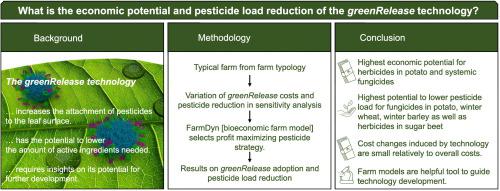Agricultural Systems ( IF 6.6 ) Pub Date : 2022-07-12 , DOI: 10.1016/j.agsy.2022.103454 T. Kuhn , N. Möhring , A. Töpel , F. Jakob , W. Britz , S. Bröring , A. Pich , U. Schwaneberg , M. Rennings

|
CONTEXT
Policies and strategies at EU and national level aim at a reduced use of pesticides in agriculture, such as the Farm to Fork Strategy of the EU Commission. Technological progress can lower pesticide application and contribute to a sustainable bioeconomy. As an example, the greenRelease technology increases the attachment of the active ingredient of plant protection products to the leaf surface and slowly releases the active ingredient from a microgel container. Experiments under both controlled and field conditions have demonstrated the potential of the greenRelease technology to reduce pesticide use. As a so-called platform technology, the greenRelease concept can be applied to various crops and plant protection chemicals.
OBJECTIVE
To guide further development, this study analyses the greenRelease technology regarding its economic potential and its possible contribution to the reduction of environmental and health risks from pesticide use.
METHODS
To do so, we use a bio-economic farm model to assess the technology potential for a typical farm and spraying sequences of various crops in northwestern Germany.
RESULTS AND CONCLUSIONS
The results reveal that the economic potential of the greenRelease technology is highest for systemic fungicides in all assessed crops as well as for herbicides for potato cultivation. It is lowest for insecticides in winter barley and potato as well as for contact fungicides, due to the small doses and low product costs. The potential to lower possible environmental and health risks of pesticide use, indicated by the Danish pesticide load indicator, is highest for fungicides in potato, winter wheat, and winter barley as well as for herbicides in sugar beet cultivation. Relative to overall costs in arable farming, the cost changes induced by the greenRelease technology are minor, such that the environmental benefits will be key for promoting its application. However, the economic competitiveness of the technology increases if agri-environmental policies progressively internalize the negative externalities of pesticides use.
SIGNIFICANCE
This research is the first comprehensive economic and environmental assessment of the technology greenRelease which can contribute to lower the environmental burden of pesticide use in agriculture.
中文翻译:

使用生物经济农场模型评估 greenRelease 技术的经济潜力和农药减量
语境
欧盟和国家层面的政策和战略旨在减少农药在农业中的使用,例如欧盟委员会的农场到餐桌战略。技术进步可以减少农药的使用并促进可持续的生物经济。例如,greenRelease 技术增加了植物保护产品的活性成分对叶面的附着,并从微凝胶容器中缓慢释放活性成分。在受控条件和现场条件下的实验证明了 greenRelease 技术在减少农药使用方面的潜力。作为一种所谓的平台技术,greenRelease 概念可以应用于各种作物和植保化学品。
客观的
为了指导进一步的发展,本研究分析了 greenRelease 技术的经济潜力及其对减少农药使用带来的环境和健康风险的可能贡献。
方法
为此,我们使用生物经济农场模型来评估德国西北部典型农场和各种作物喷洒序列的技术潜力。
结果和结论
结果表明,对于所有评估作物的内吸性杀菌剂以及用于马铃薯种植的除草剂,greenRelease 技术的经济潜力最高。由于剂量小,产品成本低,冬大麦和马铃薯中的杀虫剂以及接触性杀菌剂中的杀虫剂最低。丹麦农药负荷指标表明,降低农药使用可能带来的环境和健康风险的潜力最大的是马铃薯、冬小麦和冬大麦中的杀菌剂以及甜菜种植中的除草剂。相对于耕地整体成本,greenRelease技术带来的成本变化较小,环境效益将是推广其应用的关键。然而,
意义
这项研究是对技术greenRelease的第一次综合经济和环境评估,该技术有助于降低农业农药使用的环境负担。



























 京公网安备 11010802027423号
京公网安备 11010802027423号